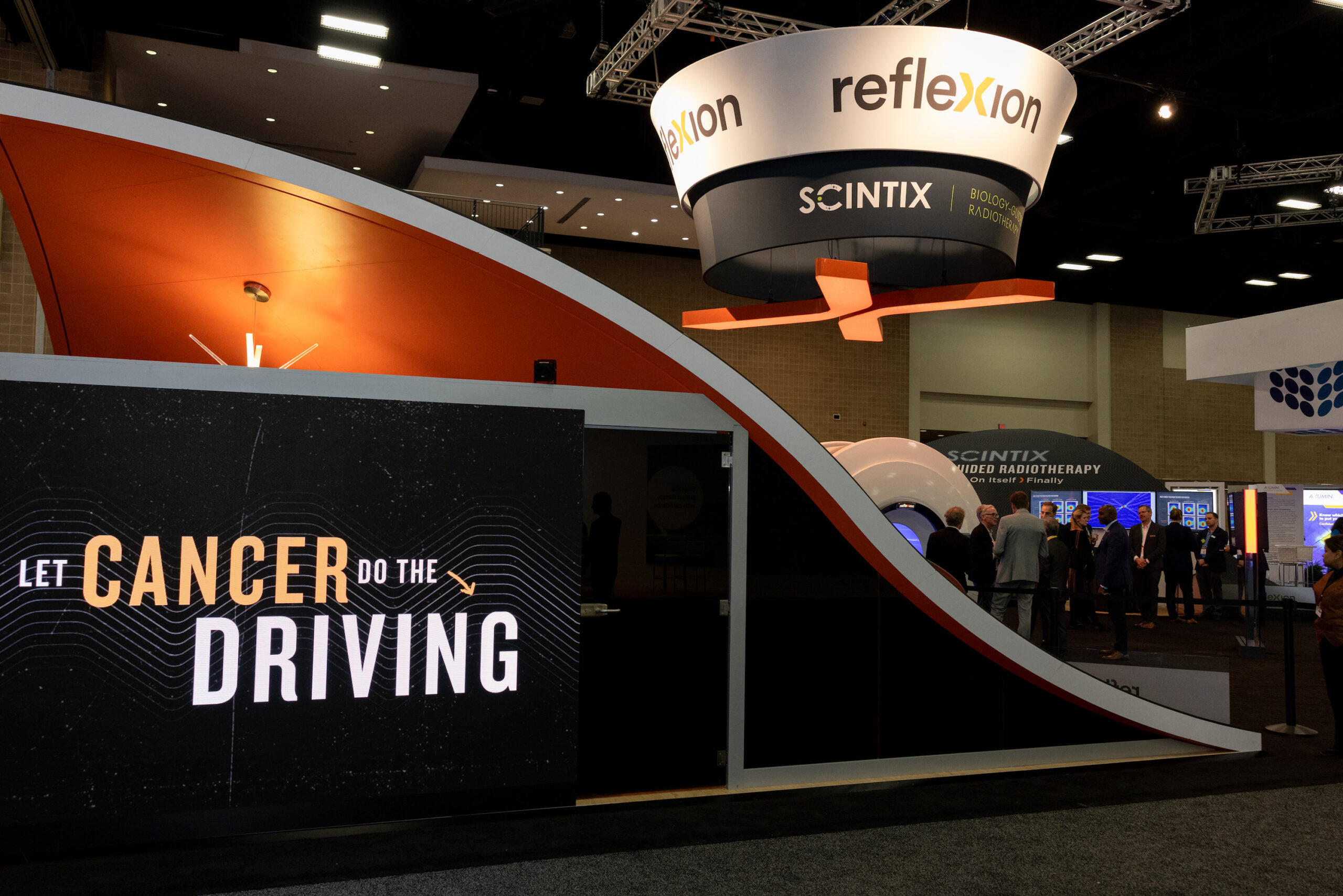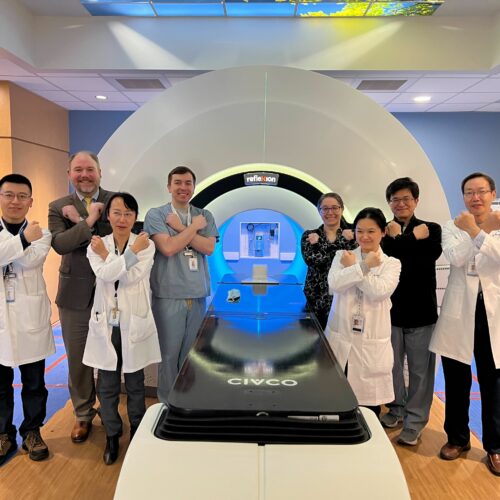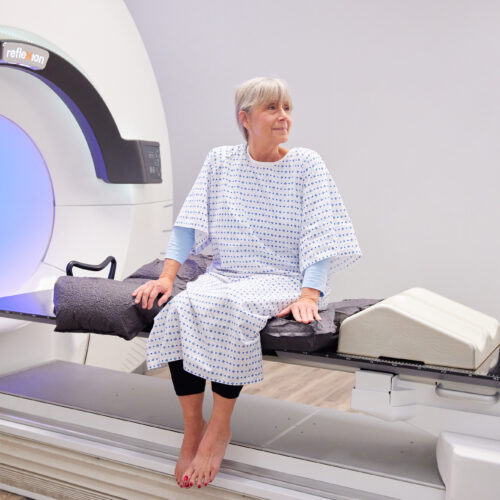
ASTRO
RefleXion Highlights at ASTRO 2022: SCINTIX Therapy, Science and Sharing
December 21, 2022
Booth #3745 in the exhibit hall at ASTRO’s annual conference in San Antonio, Texas, was bustling with activity. Thousands of radiation oncologists convene at ASTRO each year to learn and share advances in radiotherapy planning and treatment. Conference attendees stopped by to ask questions and watch demonstrations of RefleXion Medical’s X1 platform. For the first time, we introduced SCINTIX™ as the new product name for our flagship biology-guided radiotherapy (BgRT)1.
Our clinical partners presented eight clinical abstracts: six ePosters and two oral presentations.
This year, RefleXion and our clinical partners presented eight clinical abstracts: six ePosters and two oral presentations. We held live demonstrations of our breakthrough tracked dose delivery technology that uses radiopharmaceuticals as biological beacons and the SCINTIX treatment planning workflow. And with our partners, we shared new and ongoing research developments into the efficacy of our X1 platform and SCINTIX biology-guided radiotherapy.
ePosters
In one presentation, researchers shared their findings from a retrospective study that evaluated the treatment plan quality and delivery efficiency for intensity-modulated radiation therapy (IMRT) and stereotactic body radiation therapy (SBRT). The study examined 42 patient plans across six cancer sites—conventionally-fractionated lung, head and neck, anus, prostate, brain, and lung SBRT—planned with the Eclipse treatment planning system and treated with either a TrueBeam or Trilogy. Two corresponding plans were generated on the X1 treatment planning system for each Eclipse VMAT plan. The X1 treatment planning system generated clinically acceptable IMRT/SBRT treatment plans for both 10 mm and 20 mm jaw settings. Researchers found that the X1 10mm plans were equivalent or superior to the Eclipse VMAT plans; however, the beam-on times were longer.
Radiomic features obtained from daily treatment images from the X1’s imaging system have the potential to be used for cancer prognosis and treatment response assessment. Researchers presented a study that aimed to establish the technical validation of the repeatability and reproducibility of radiomic features produced by the X1’s kilovoltage computed tomography (kVCT). The Credence Cartridge Radiomics phantom was scanned 10 times on the X1 system over a three-month timeframe using head/medium dose/fast couch and body/medium dose/slow couch—the two most frequently used scanning protocols. Sixty-six radiomic features were extracted using a widely available IBSI-compliant radiomics software package. The study authors found no significant variation in radiomic features over time. The X1 produced clinically valuable CT radiomic features that were shown to be reproducible over time, thus concluding its usefulness as a quantitative imaging platform.
The feasibility and dosimetric benefits of adaptive planning in prostate cancer radiotherapy were the subjects of another presentation. The retrospective study analyzed daily kVCT scans acquired on days 1, 5, 13, 17 and 22 of a post-prostatectomy patient treated with 44 Gy/22 fractions to the prostate bed and lymph nodes. Researchers found that with adaptive planning, the interfraction dose variation was minimal because adaptive plans were optimized based on daily kVCT images, which is one primary benefit of adaptive planning. The high-quality kVCT images produced have the potential to be used to delineate targets and organs at risk. kVCT adaptive planning, which will account for possible interfraction variations, could further improve treatment delivery.
Researchers shared their findings from an exploration of deep learning-based, patient-specific auto-segmentation to facilitate adaptive radiotherapy. Data used came from the first patient with head-and-neck cancer treated using the X1. Researchers chose the esophagus, larynx and pharynx as the organs at risk for auto-segmentation analysis. They studied auto-segmentation on daily kVCT images based on patient-specific learning to facilitate future adaptive radiotherapy. They determined that the patient-specific network could achieve much better contouring and dosimetric accuracy and has the potential to be a promising, powerful tool in adaptive radiotherapy applications.
Another presentation shared the findings of a study that evaluated PET biodistribution changes within a target during BgRT delivery. For the study, researchers designed two phantom experiments to evaluate the effects of fluorodeoxyglucose (FDG) signal variations on dosimetric accuracy of delivery for stationary targets and moving targets on the X1. The study suggests that BgRT delivery is robust with respect to variations of PET signal under these experimental conditions. Researchers advised that clinical feasibility of BgRT needs further evaluation.
In the sixth presentation, researchers focused on characterizing the epidemiology of metastatic non-small cell lung cancer (NSCLC) in an era of changing treatment paradigms. Researchers at an academic medical center evaluated the extent and burden of metastatic disease in patients with NSCLC and determined the incidence of patients who meet existing criteria for ‘oligometastatic’ disease. The study included 108 patients with a median age of 68; 81 (75 percent) presented with de novo metastatic disease, while 27 (25 percent) presented with recurrence. The study found that most patients presenting with metastatic NSCLC had initial de novo metastatic presentation, multi-organ involvement, and adenocarcinoma histology. Roughly one-third of patients were classified as oligometastatic using existing trial criteria, and only a minority of these patients were treated with local therapy after diagnosis.
Oral Presentations
Researchers explained how they evaluated the performance of FDG-guided BgRT for respiratory and non-respiratory (gastrointestinal) motion management while exploring spherical and non-spherical target shapes. BgRT is designed to provide target coverage while keeping organ-at-risk doses low. For this study, researchers used a large custom anthropomorphic phantom with two robotic articulating arms to place a target and organ-at-risk inside a 27-liter water-filled cavity. Three different 10 Gy/fraction treatment plans with two different target shapes and realistic nearby organs-at-risk were created. Researchers determined that BgRT can provide motion management in complex cases that are agnostic to the type of motion.
The second oral presentation focused on an investigation of the feasibility of a combined theranostic/BgRT treatment for patients with metastatic castrate-resistant prostate cancer who had discordance between Gallium-68 (68Ga) PSMA-11 and FDG PET uptake at screening. Researchers found that sixty-seven percent of FDG-only avid tumors were suitable for BgRT treatment. They determined the feasibility of BgRT treatment to FDG-only avid tumors in combination with Lutetium PSMA, a novel theranostic treatment that has demonstrated high response and low toxicities in patients with metastatic castrate-resistant prostate cancer.
Sharing to Support Patients with Lung Cancer
RefleXion is working diligently to one day commercialize its X1 platform with SCINTIX technology to offer new hope for patients with advanced cancer. It also supports patients by supporting organizations through grants and donations. At ASTRO’s 2022 Annual Conference, RefleXion awarded grant funding to LUNGevity Foundation and G02 Foundation for Lung Cancer. “When the Food and Drug Administration awarded RefleXion breakthrough device designation in 2021 for the treatment of lung tumors, I got really excited,” says Susan Thompson, RefleXion’s senior director, Patient Access. “At ASTRO, we chose to support LUNGevity and the G02 Foundation because we have the same mission—namely, to offer people living with lung cancer the opportunity for better, longer lives.”
Advances in early detection, screening, and enhanced drug therapies have improved overall survival rates, but patients with advanced lung cancers still need breakthroughs in technologies and treatment to improve overall survivorship and quality of life. They also need support. LUNGevity Foundation invests in early detection and therapeutics to help patients with lung cancer live better and improve the current five-year survival rate. The foundation also aims to empower patients in decision-making about treatments and supports patients through online peer-to-peer support and in-person survivorship programs. The G02 Foundation for Lung Cancer helps patients with lung cancer navigate through detection, diagnosis and treatment. It aims to improve care, increase awareness and advocacy, and support innovative research. With RefleXion’s focus on lung cancer, among other disease sites, awarding funds to these two organizations was a natural fit.
Why ASTRO 2022 Is Pivotal
As a relatively new entrant into a field with longstanding technologies, presenting at ASTRO is a critical way for us to showcase our technology, meet with current and prospective clients, and share the scientific results from the many research collaborations with our partners. “This year’s body of work highlighted the advanced conventional capabilities of the X1 and revealed key future possibilities for SCINTIX technology in which each tumor’s unique biology directs its own treatment,” said Sean Shirvani, M.D., M.P.H, RefleXion’s chief medical officer. “It was a great opportunity to showcase the current and future potential of RefleXion’s contributions in the fight against cancer.”
[1] The RefleXion® X1 is cleared for SBRT/SRS/IMRT treatments. SCINTIX biology-guided radiotherapy is limited by U.S. law to Investigational use.




